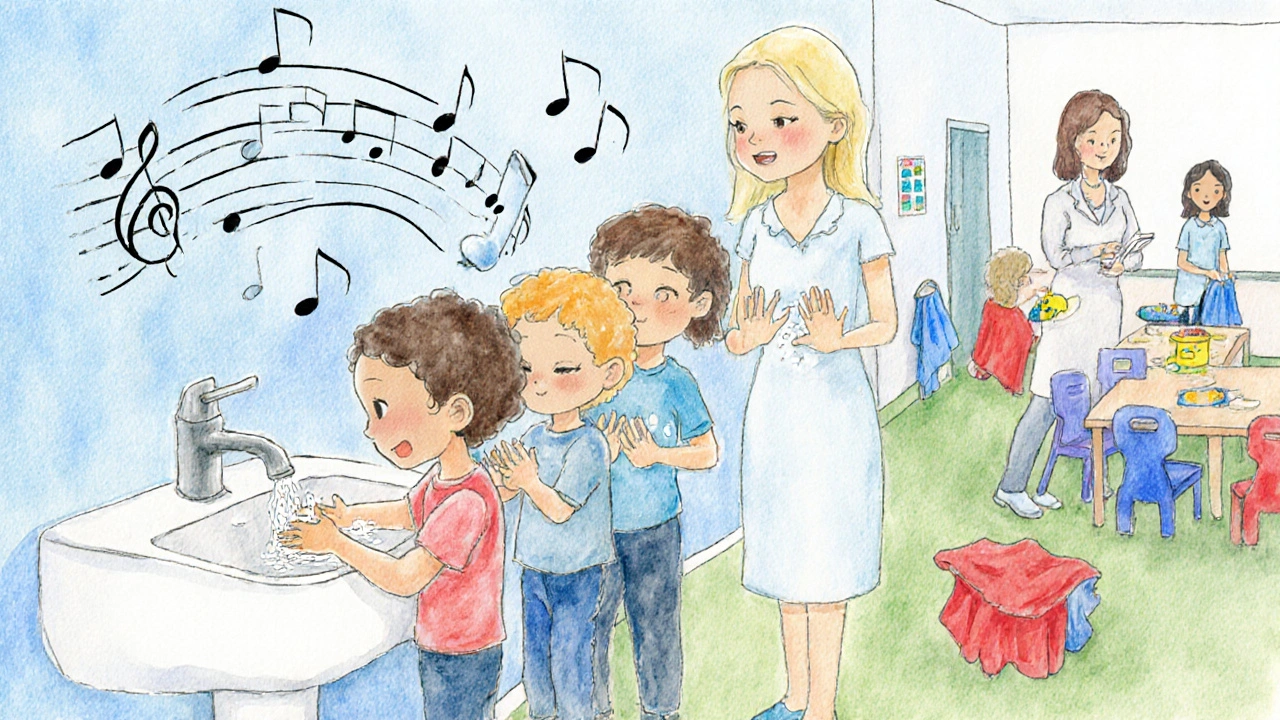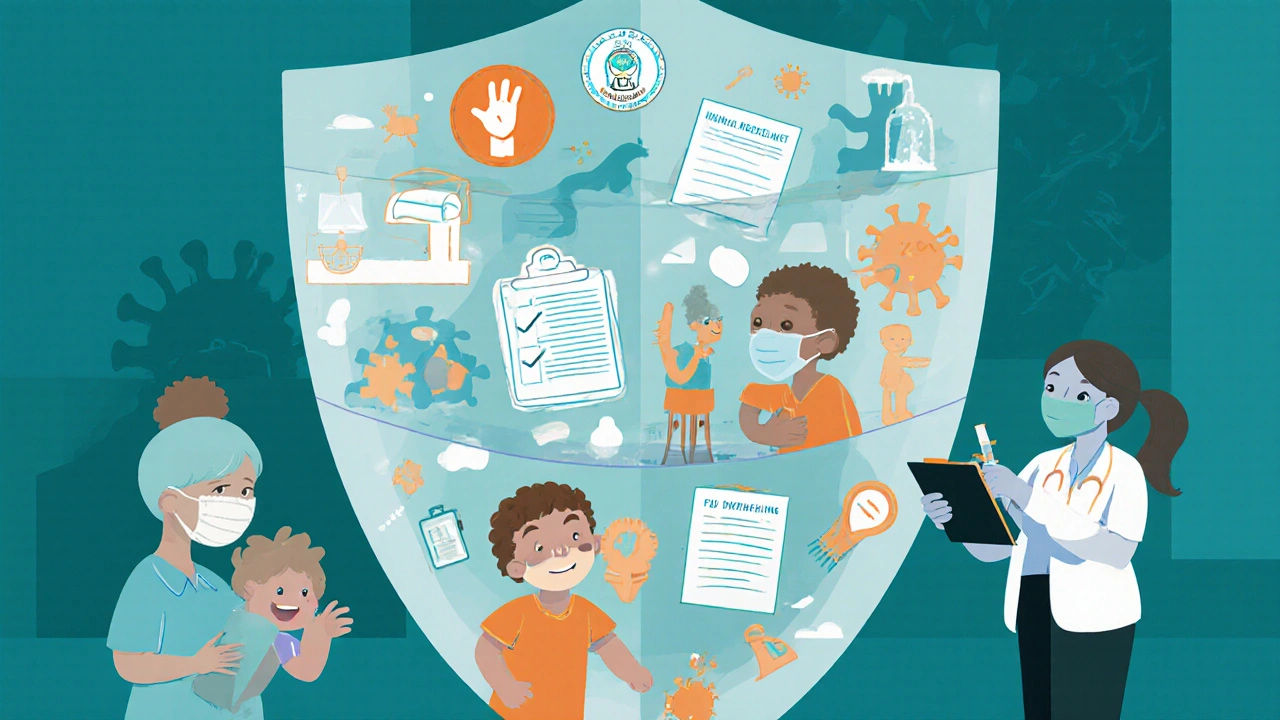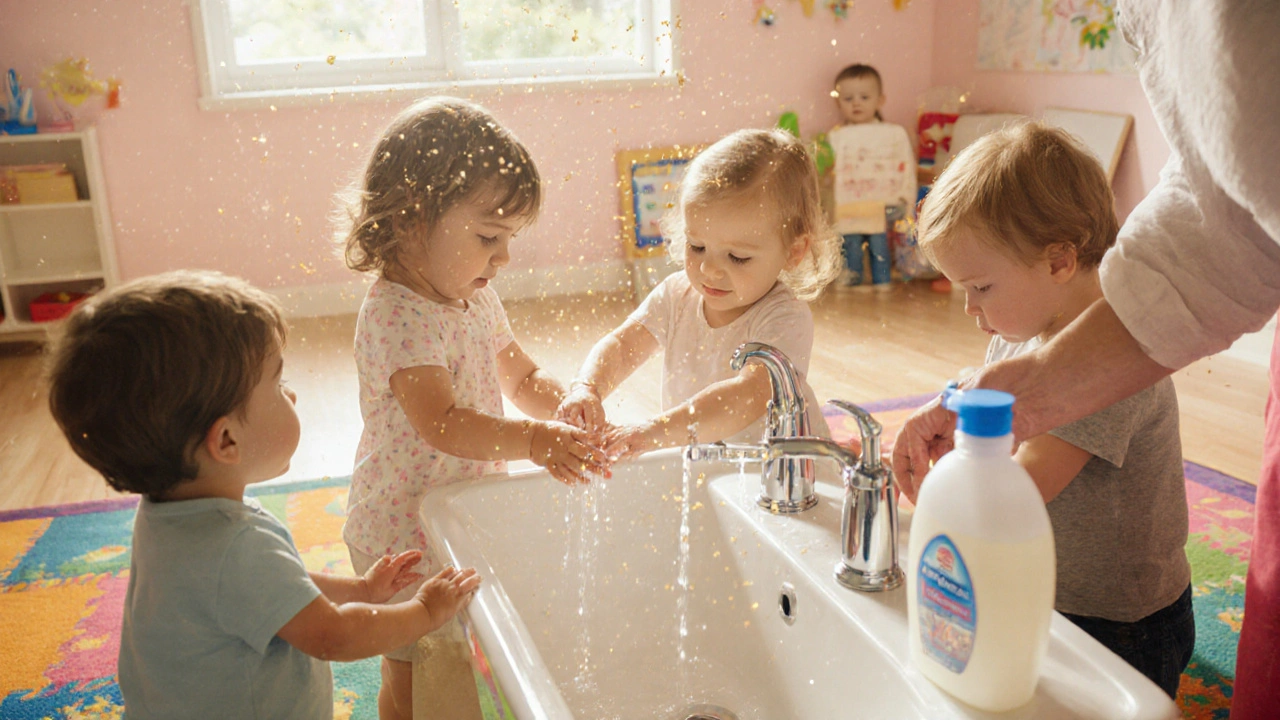Childcare Infection Control Checklist
Complete the checklist below to assess your childcare facility's infection control practices.
Your Infection Control Status
When kids gather in a classroom, a playroom, or a nap area, germs can travel faster than a game of tag. Infection control is a set of practices designed to stop that spread, keeping little bodies healthy and peace of mind intact for parents and staff.
Key Takeaways
- Effective infection control cuts illness rates by up to 50% in childcare centers.
- Hand hygiene, surface cleaning, and vaccination are the three pillars of a safe environment.
- Clear policies, regular training, and quick outbreak response protect both children and staff.
- Compliance with local health regulations avoids fines and builds trust with families.
- Monitoring symptoms daily helps catch problems before they turn into full‑blown outbreaks.
What Makes Childcare Settings High‑Risk?
Children ages 0‑5 are still mastering personal hygiene. Their immune systems are developing, and they love to put toys, fingers, and even whole objects in their mouths. This combination creates a perfect storm for gastroenteritis (stomach flu), a viral or bacterial infection causing diarrhea and vomiting and respiratory infections like the common cold or RSV. Add in close contact during play, shared surfaces, and the occasional sneezed‑on blanket, and you have a recipe for rapid transmission.
Core Infection‑Control Measures
Experts agree that three core practices form the backbone of any effective program.
1. Hand Hygiene
Hand hygiene involves washing hands with soap and water for at least 20seconds or using an alcohol‑based hand rub (ABHR) when water isn’t available. Studies from the New Zealand Ministry of Health show a 40% drop in absenteeism when centers enforce strict hand‑washing protocols.
- Teach children the “song‑and‑scrub” routine to make timing easy.
- Place sinks or disinfectant dispensers at child‑height in each activity area.
- Assign a staff member to model proper technique at snack time.
2. Cleaning and Disinfection
Cleaning removes dirt; disinfection kills the germs left behind. Surface cleaning should happen at least three times a day in high‑traffic zones. Use EPA‑approved disinfectants that are safe for children, and follow the manufacturer’s contact time.
- Focus on toys, tables, doorknobs, and bathroom fixtures.
- Adopt a color‑coded cloth system (e.g., red for bathroom, blue for play area) to avoid cross‑contamination.
- Document cleaning schedules on a visible chart for accountability.
3. Vaccination
Vaccines are the most powerful defense against preventable diseases. In New Zealand, the Ministry of Health requires proof of immunisation for measles, mumps, rubella, pertussis, and varicella before a child can enroll in licensed childcare.
- Collect up‑to‑date immunisation records during enrolment.
- Offer annual flu vaccines on site or partner with a local clinic.
- Maintain a confidential log to track coverage and identify gaps.

Daily Illness Screening
Morning health checks catch early signs of infection. A simple questionnaire for parents-asking about fever, cough, vomiting, or rash-combined with a quick visual assessment by staff can prevent a sick child from joining the group.
When a child shows symptoms, follow the centre’s illness policy (often called an exclusion or sick‑child policy). Typical steps include:
- Separate the child in a designated area.
- Notify parents immediately and arrange safe transport home.
- Record the incident in a log for future trend analysis.
- Increase cleaning frequency for the areas the child used.
Outbreak Management
Even with the best practices, outbreaks can still happen. The key is a rapid, coordinated response.
- Identify the pathogen: Contact the local health authority to arrange lab testing if the outbreak exceeds a set threshold (e.g., five cases of gastroenteritis within 48hours).
- Notify stakeholders: Inform all families, staff, and the health department about the situation and steps being taken.
- Implement control measures: Temporarily close affected rooms, deepen cleaning, and enforce strict hand‑hygiene reinforcement.
- Review and adjust policies: Conduct a post‑outbreak debrief to pinpoint gaps and update procedures.
In a 2022 Wellington early‑learning centre, a norovirus outbreak was curtailed in three days thanks to immediate isolation, enhanced surface disinfection, and clear communication with parents.
Regulatory Landscape
Childcare providers must comply with national and local health regulations. In New Zealand, the Health and Safety at Work Act 2015 mandates that employers provide a safe environment, which includes infection‑control measures.
Licensing agencies, such as the Ministry of Education’s Early Childhood Education (ECE) regulatory framework, require documented policies covering hand hygiene, cleaning, and exclusion criteria. Failure to meet these standards can lead to fines, loss of licence, and damage to reputation.

Training and Culture
Policies are only as good as the people who follow them. Ongoing training turns infection control from a checkbox into a shared culture.
- Schedule quarterly workshops for staff on the latest hygiene guidelines.
- Use role‑play scenarios to practice responding to a sick child.
- Celebrate “Clean‑Day” achievements with simple rewards (stickers, recognition boards).
- Encourage parents to model hand‑washing at pick‑up and drop‑off.
A centre in Auckland reported a 30% reduction in sick days after introducing monthly “hygiene champions” among staff.
Practical Checklist for Providers
| Area | Action | Frequency |
|---|---|---|
| Hand Hygiene | Provide soap, water, and ABHR; teach proper technique | Continuous; audit weekly |
| Surface Cleaning | Wipe toys, tables, and bathroom fixtures with approved disinfectant | At least 3× per day; after each illness |
| Vaccination Records | Collect and verify up‑to‑date immunisations | At enrolment; annual review |
| Illness Screening | Morning health questionnaire; visual check | Every arrival |
| Staff Training | Conduct hygiene workshops and outbreak drills | Quarterly |
| Policy Review | Update exclusion and cleaning policies based on latest guidelines | Bi‑annual |
Putting It All Together
Think of infection control as a three‑layer shield: personal habits (hand hygiene), environmental safeguards (cleaning, vaccination), and systemic support (policies, training, regulation). When each layer is strong, the whole centre stays healthier.
Start small: pick one area-say, hand‑washing stations-and make it child‑friendly. Track improvements in absenteeism, celebrate wins, and gradually add the other layers. The result isn’t just fewer sick days; it’s a trustworthy environment where families feel safe and staff feel empowered.
Frequently Asked Questions
How often should toys be disinfected?
High‑touch toys (blocks, puzzles, dolls) should be wiped with an approved disinfectant at least three times a day and immediately after any child shows signs of illness.
What is the recommended hand‑washing duration for preschoolers?
Twenty seconds is the benchmark. Using a short song (like “Happy Birthday” twice) helps children keep time without counting.
Can I use regular household bleach for surface cleaning?
Yes, a solution of 1part bleach to 9parts water (≈1000ppm) is effective and approved by the EPA for disinfecting surfaces in childcare. Rinse after the required contact time and allow to air‑dry.
What steps should I take if a child develops a fever during the day?
Separate the child, notify parents immediately, and follow the centre’s exclusion policy (typically 24hours fever‑free after medication). Increase cleaning in the area the child used and document the incident for future review.
How can I involve parents in infection‑control efforts?
Send regular newsletters with hand‑hygiene tips, post visible hand‑washing reminders, and ask parents to keep immunisation records current. Encouraging parents to model good hygiene at drop‑off strengthens the overall culture.


Asia Lindsay
Great rundown! 🌟 Hand‑washing stations at child‑height are a game‑changer, and a quick song makes the 20‑second rule stick. Keep up the awesome work, you’ve got this! 😊
Angela Marie Hessenius
In the tapestry of early childhood education, infection control threads itself through every interaction, binding health, trust, and cultural nuance into a cohesive fabric.
From the bustling nurseries of New York to the serene play‑rooms of rural Kerala, the universal challenge remains the same: how to protect our tiniest citizens from invisible adversaries.
The checklist presented elegantly captures the essential pillars-hand hygiene, surface sanitation, vaccination-yet each pillar carries cultural weight that varies across communities.
For instance, the ritual of hand‑washing can double as a moment of mindfulness, echoing ancient practices of purity found in many societies.
When educators teach the "song‑and‑scrub" routine, they are not only imparting a health habit but also weaving a musical tradition that resonates with children’s love of rhythm.
Similarly, the choice of disinfectant should respect local preferences; some families may favor natural, plant‑based solutions over harsh chemicals, demanding a balanced approach that satisfies regulatory standards while honoring cultural sensibilities.
Vaccination records, while a bureaucratic necessity, also serve as a bridge between public health policy and community trust, especially in regions where vaccine hesitancy can stem from historical grievances.
Transparent communication, perhaps through multilingual newsletters, can demystify the process and encourage parental cooperation.
The daily illness screening questionnaire, though succinct, reflects a cultural dialogue; asking parents about fevers in a respectful tone acknowledges their role as primary caregivers.
When a child displays symptoms, the exclusion policy must be applied consistently, yet with compassion, ensuring that the child feels cared for rather than ostracized.
Outbreak management plans, as highlighted in the Wellington case study, demonstrate the power of rapid response, but they also illustrate the importance of community solidarity during a crisis.
Training sessions that incorporate role‑play not only improve procedural knowledge but also celebrate storytelling traditions, making the learning experience memorable.
In many cultures, recognizing the wisdom of elders is paramount; involving senior staff in these drills can lend authority and reassurance to younger educators.
The checklist’s color‑coded cloth system is a simple visual cue, yet it mirrors the universal human tendency to categorize and organize our environment for better safety.
By documenting cleaning schedules on a visible board, centers create a culture of accountability that transcends language barriers.
Ultimately, infection control is not a sterile checklist but a living practice that intertwines health science with the rich tapestry of cultural values that each child brings to the classroom.
Julian Macintyre
It is incumbent upon every early‑learning institution to rigorously adhere to the established protocols delineated herein, for the gravitas of such measures cannot be overstated. The statistical diminution of absenteeism, reaching upwards of fifty percent, constitutes a compelling argument for the unwavering implementation of hand‑hygiene regimens. Moreover, the precise calibration of disinfectant contact time, as stipulated by the EPA, embodies the scientific rigor requisite for efficacious pathogen eradication. Failure to comply not only jeopardises the health of the nascent cohort but also heralds potential sanctions under the Health and Safety at Work Act 2015. Accordingly, administrators must ensure that the requisite documentation, encompassing cleaning logs and vaccination verifications, is maintained with scrupulous exactitude. In summation, the tripartite framework of personal, environmental, and systemic safeguards represents the cornerstone of a resilient childcare ecosystem.
Patrick Hendrick
Love the checklist!,, it’s clear, concise,, and ready‑to‑use.!! Keep spreading these gems!!
abhishek agarwal
Look, the facts are clear – you need strict hand‑washing stations, regular surface disinfection, and up‑to‑date immunisation records. I’m telling you, if you slack off, you’ll see sick days rise, and nobody wants that. So get the policies in place, train the staff, and enforce them daily. No excuses.
Michael J Ryan
Excellent summary! I especially appreciate the emphasis on documenting cleaning schedules – it not only ensures compliance but also builds trust with families. If anyone needs clarification on the EPA‑approved disinfectants, feel free to ask; I’m happy to share reliable sources. Let’s keep the conversation going and make our childcare settings safer together.
Khalil BB
Infection control is the silent guardian of childhood – unnoticed until it fails.
Nick Ham
From a risk‑mitigation standpoint, the integration of SOPs for hand‑hygiene, environmental decontamination, and immunisation compliance constitutes a robust infection‑control framework. Leveraging KPI dashboards to monitor adherence rates can drive data‑driven improvements, while variance analysis flags non‑conformities for corrective action.
Jeremy Olson
I commend the comprehensive approach outlined herein. The balance between regulatory compliance and compassionate care reflects best‑practice standards in early‑childhood settings. Should you require assistance in drafting policy documents or conducting staff workshops, I would be pleased to contribute.